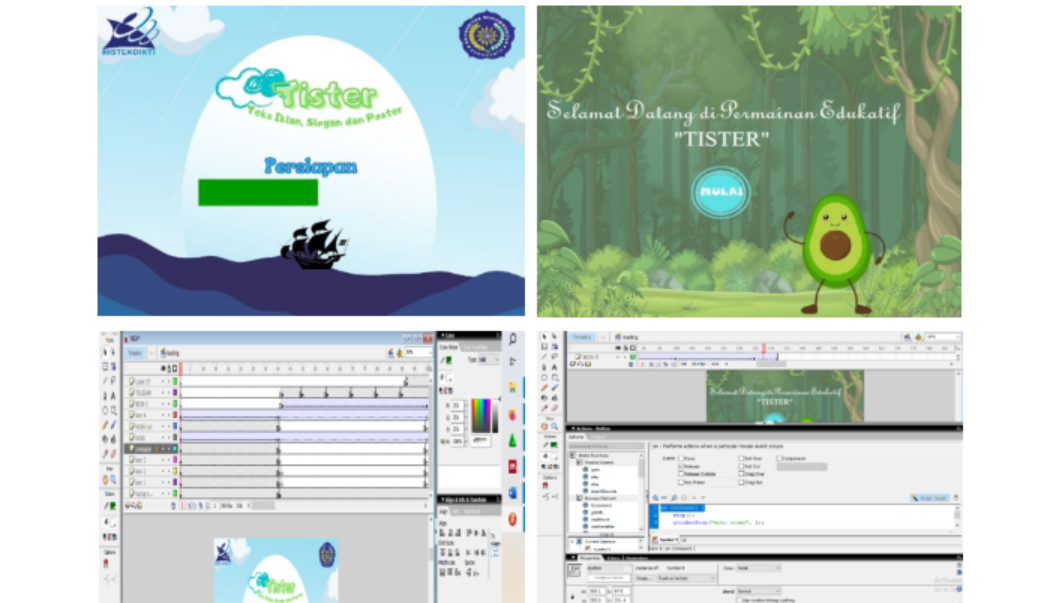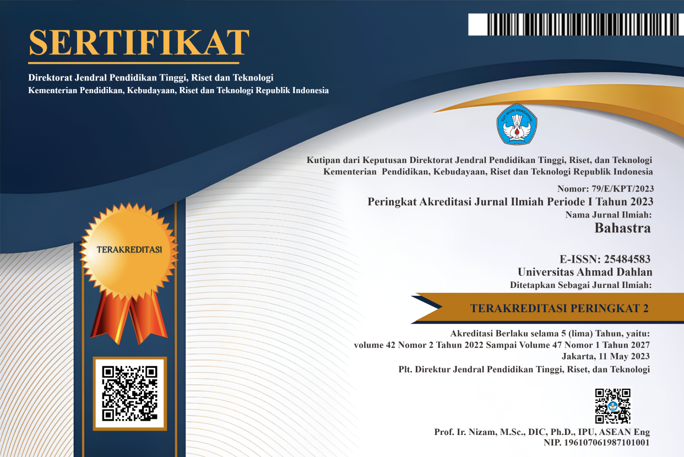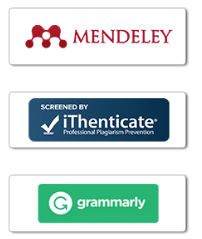Educational game based on macromedia flash in Indonesian language learning in junior high school
DOI:
https://doi.org/10.26555/bs.v43i2.521Keywords:
Fisher Yates Shuffle Algorithm, Indonesian Language Learning, Educational GamesAbstract
Educational Game is an application package that is used as a tool that aims to encourage students to undergo learning activities. The objectives of this study are (1) to describe educational games based on Macromedia Flash for Indonesian language learning in junior high schools; and (2) to describe the results of implementing Macromedia Flash-based educational games with the Fisher Yates Shuffle algorithm in learning Indonesian in junior high schools. The research approach is a qualitative descriptive research. The research is based on case studies with subjects and objects that focus on class VIIIC students and Indonesian language teachers at SMP Negeri 2 Jatisrono. Data collection techniques are by using observation techniques, questionnaires, interviews, and tests. The research sample is 30 VIIIC students. Data analysis is guided by Miles & Huberman's view which consists of three streams of activities that occur simultaneously, namely: data reduction, data presentation, drawing conclusions/verification. The data validity test was carried out using source triangulation technique. In connection with the research results based on eight indicators, it can be understood that the level of student activity in learning Indonesian based on educational games based on Macromedia Flash with the Fisher Yates Shuffle algorithm has increased. The percentage of 87% of students explained that the Macromedia Flash application based on the Fisher Yates Shuffle algorithm was able to increase student activity. This research encourages the integration of technology in the world of education. Flash-based games can offer interactive and dynamic content, enhancing the learning experience.
References
Abdulrahman, T., Basalama, N., & Widodo, M. R. (2018). The impact of podcasts on EFL students’ listening comprehension. International Journal of Language Education, 2(2), 23–33. https://doi.org/10.26858/ijole.v2i2.5878
Agustina, A., Nurhayati, N., Suhendi, D., & Vianty, M. (2022). Effectiveness of learning media for drama performances based on syair perang menteng using macromedia flash. ILE&L: Indonesian Language Education and Literature, 8(1), 86–99. https://doi.org/10.24235/ileal.v8i1.11455
Alias, N., Rosman, F., Rahman, M. N. A., & Dewitt, D. (2015). The potential of video game in Malay language learning for foreign students in a public higher education institution. Procedia-Social and Behavioral Sciences, 176, 1020–1027. https://doi.org/10.1016/j.sbspro.2015.01.573
Amrullah, A. Z. (2015). Developing language games to teach speaking. JEELS, 2(2), 13–33. https://doi.org/10.30762/jeels.v2i2.94
Azzizah, R. N., & Nugraheni, A. S. (2022). Efektivitas pembelajaran bahasa Indonesia materi paragraf deskripsi dan eksposisi saat pandemi covid-19 melalui aplikasi youtube. Basindo: Jurnal Kajian Bahasa, Sastra Indonesia, dan Pembelajarannya, 6(1), 53–64. https://doi.org/10.17977/um007v6i12022p53-64
Beege, M., Schneider, S., Nebel, S., Häßler, A., & Rey, G. D. (2018). Mood-affect congruency. exploring the relation between secondary school learners’ mood and the emotional charge of educational videos. Computers and Education, 123(May), 85–96. https://doi.org/10.1016/j.compedu.2018.05.001
Behnamnia, N., Kamsin, A., Ismail, M. A. B., & Hayati, A. (2020). The effective components of creativity in digital game-based learning among young children: A case study. Children and Youth Services Review, 116, 1–13. https://doi.org/10.1016/j.childyouth.2020.105227
Bergen, E. van, Zuijen, T. van, Bishop, D., & Jong, P. F. de. (2017). Why are home literacy environment and children’s reading skills associated? What parental skills reveal. Reading Research Quarterly, 52(2), 147–160. https://doi.org/10.1002/rrq.160
Buffardi, K., & Valdivia, P. (2019). Bug hide-and-seek: An educational game for investigating verification accuracy in software tests. Proceedings - Frontiers in Education Conference, FIE, 18(October), 1–8. https://doi.org/10.1109/FIE.2018.8658748
Chen, S., Pan, Z., Wu, Y., Gu, Z., Li, M., Liang, Z., Zhu, H., Yao, Y., Shui, W., Shen, Z., Zhao, J., & Pan, H. (2017). The role of three-dimensional printed models of skull in anatomy education: A randomized controlled trail. Scientific Reports, 7(1), 1–11. https://doi.org/10.1038/s41598-017-00647-1
Dewi, N. T., Kusmana, S., & Mascita, D. E. (2022). The development of digital teaching materials in learning advertisement texts, slogans, and posters in SMP/MTS. International Journal of Secondary Education, 10(2), 91–96. https://doi.org/10.11648/j.ijsedu.20221002.15
Farhan, M., Ijlal, M., Aditama, D., & Chotijah, U. (2022). Color recognition educational game using fisher- yates for early childhood potential development. Jurnal Inovtek Polbeng - Seri Informatika, 7(2), 279–289. https://doi.org/10.35314/isi.v7i2.2866
Fartina, Hizbi, T., & Syahidi, K. (2020). Development of interactive physics learning media macromedia flash 8 based on straight motion material. Journal of Physics: Conference Series, 1539(1), 1–6. https://doi.org/10.1088/1742-6596/1539/1/012023
Fujiati, F., & Rahayu, S. L. (2020). Implementation of fisher yate shuffle algorithm in educational games as learning media. CogITo Smart Journal, 6(1), 1–11. https://doi.org/10.31154/cogito.v6i1.174.1-11
Giatos, G., & Srdiyatmiko, G. (2022). Utilization of the surrounding environment to increase student motivation and learning outcomes in social studies learning content. Proceedings Series on Social Sciences & Humanities, 3, 58-63.
Hazra, T. K., Ghosh, R., Kumar, S., Dutta, S., & Chakraborty, A. K. (2015). File encryption using fisher-yates shuffle. 6th International Conference and Workshop on Computing and Communication, IEMCON 2015, 15(December), 1–7. https://doi.org/10.1109/IEMCON.2015.7344521
Hiasa, F., Agustina, E., & Tawandorloh, K.-A. (2022). Implementation of the PjBL Learning Model Assisted by the TikTok Application in the Literary Expression Course. Bahastra, 42(2), 95–106. https://doi.org/10.26555/bs.v42i2.76
Inderasari, E., Hapsari, D. A., Rosita, F. Y., & Ulya, C. (2021). Analysis of the language use style in public service advertisement “being wise in social media” on radios in Surakarta. Kembara: Jurnal Keilmuan Bahasa, Sastra, dan Pengajarannya, 7(2), 508–528.
Irfan, M., Ramdhania, D. R., Nita, I. S., Priatna, T., & Atmadja, A. R. (2020). Design and build an early childhood puzzle educational game using the fisher-yates shuffle algorithm as an android-based scrambler for snippets. Proceedings - 2020 6th International Conference on Wireless and Telematics, ICWT 2020, 58, 1–6.
Irvan, Mushlihuddin, R., & Suhartini, D. (2020). Effectiveness of learning media using contextual based macromedia flash for junior school students Al Hikmah Medan. Journal of Physics: Conference Series, 1429(1), 1–5. https://doi.org/10.1088/1742-6596/1429/1/012002
Jojor, A., & Sihotang, H. (2022). Analisis kurikulum merdeka dalam mengatasi learning loss di masa pandemi covid-19 (Analisis studi kasus kebijakan pendidikan). Edukatif : Jurnal Ilmu Pendidikan, 4(4), 5150–5161. https://doi.org/10.31004/edukatif.v4i4.3106
Karawia, A. (2019). Image encryption based on fisher-yates shuffling and three dimensional chaotic economic map. IET Image Processing, 13(12), 2086–2097. https://doi.org/10.1049/iet-ipr.2018.5142
Kesuma, D. S., Zakirman, Z., Berli, A. U., Meilisa, M., & Rahayu, C. (2022). Fun science methods to improve student s ’ activeness in science learning. Edukatif : Jurnal Ilmu Pendidikan, 4(1), 530–538. https://doi.org/10.31004/edukatif.v4i1.1759
Khadijah, K., Pulungan, E. N., Hariati, R., & Maisarah, M. (2022). Developing the educational game tool to improve reading ability of early childhood. IJoLE: International Journal of Language Education, 6(1), 25–35. https://doi.org/10.26858/ijole.v6i1.20145
Khair, U., Rihan K, E., & Misnawati, M. (2021). Indonesian language teaching in elementary school: cooperative learning model explicit type instructions chronological technique of events on narrative writing skills from interview texts. Linguistics and Culture Review, 6(52), 172–184. https://doi.org/10.21744/lingcure.v6ns2.1974
Kholida, S.I., Suprianto, & Mahardika, I. K. (2020). Development of work sheet students in guided inquiry based on the game education using macromedia flash. Journal of Physics: Conference Series, 1569(2), 1–8. https://doi.org/10.1088/1742-6596/1569/2/022006
Laine, T. H., & Lindberg, R. S. N. (2020). Designing engaging games for education: a systematic literature review on game motivators and design principles. IEEE Transactions on Learning Technologies, 13(4), 804–821. https://doi.org/10.1109/TLT.2020.3018503
Laiya, M. S., Nursaadah, M., Durand, W. S., Libya, A., & Rahmat, A. (2022). Enhancement liveliness and knowledge participant educate in class 4 science subjects through game media wheel play smart in SD Laboratory UNG. Periodica: Journal of Modern Philosophy, Social Sciences and Humanities, 13(2720), 80–83.
Latifah, U., Busri, H., & Badrih, M. (2023). The aesthetic rhetoric of the language of online advertising in ramadan 2022: A functional study of the prague school. KEMBARA: Jurnal Keilmuan Bahasa, Sastra, dan Pengajarannya, 9(1), 285–299.
Leong, L., & Ahmadi, S. M. (2017). An analysis of factors influencing learners’ english speaking skill. International Journal of Research in English Education, 1(1), 34–41. https://doi.org/10.18869/acadpub.ijree.2.1.34
Loren, F. T. A., Andayani, A., & Setiawan, B. (2017). The use of learning media on listening skill in teaching indonesian to speakers of other language (TISOL). Lingua Didaktika: Jurnal Bahasa dan Pembelajaran Bahasa, 11(1), 1–12. https://doi.org/10.24036/ld.v11i1.7625
Maryono, I., Zulfikar, W. B., & Kariadinata, R. (2018). The implementation of fisher yates shuffle on aljabar learning media based on hybrid application. MATEC: Web of Conferences The 3rd Annual Applied Science and Engineering Conference (AASEC 2018), 197(September), 1–5.
Masykur, R., Nofrizal, N., & Syazali, M. (2017). Pengembangan media pembelajaran matematika dengan macromedia flash. Al-Jabar: Jurnal Pendidikan Matematika, 8(2), 177–186. https://doi.org/10.24042/ajpm.v8i2.2014
Mayer, R. E. (2019). Computer games in education. Annual Review of Psychology, 70, 531–549. https://doi.org/10.1146/annurev-psych-010418-102744
McGeown, S. P., Duncan, L. G., Griffiths, Y. M., & Stothard, S. E. (2015). Exploring the relationship between adolescent’s reading skills, reading motivation, and reading habits. Reading and Writing, 28(4), 545–569. https://doi.org/10.1007/s11145-014-9537-9
Mee, R. W. M., Pek, L. S., Von, W. Y., Ghani, K. A., Shahdan, T. S. T., Ismail, M. R., & Rao, Y. S. (2021). A conceptual model of analogue gamification to enhance learners ’ motivation and attitude. IJoLE: International Journal of Language Education, 5(2), 40–50. https://doi.org/10.26858/ijole.v5i2.18229
Miller, J. L., & Kocurek, C. A. (2017). Principles for educational game development for young children. Journal of Children and Media, 11(3), 1–16. https://doi.org/10.1080/17482798.2017.1308398
Momang, H. D. (2021). Pengembangan model buku ajar digital keterampilan menyimak berdasarkan pendekatan autentik. KEMBARA Journal of Scientific Language Literature and Teaching, 7(1), 71–93. https://doi.org/10.22219/kembara.v7i1.16202
Montiel-Ruiz, F. J., Sánchez-Vera, M. D. M., & Solano-Fernández, I. M. (2023). Social networks and gamification in physical education: A case study. Contemporary Educational Technology, 15(1), 1–15. https://doi.org/10.30935/cedtech/12660
Muji, A. P., Ambiyar, A., Aziz, I., & Hidayat, H. (2021). The implementation of quizizz-based online evaluation in higher education: An exciting alternative for evaluation. International Journal of Research in Counseling and Education, 5(2), 149–157. https://doi.org/10.24036/00478za0002
Muliya, M. (2022). Penerapan media quizizz dalam meningkatkan hasil belajar siswa pada mata pelajaran bahasa Indonesia kelas x busana 2. Enggang: Jurnal Pendidikan, Bahasa, Sastra, Seni, dan Budaya, 3(1), 1–14. https://doi.org/10.37304/enggang.v3i1.7404
Musanna, F., & Kumar, S. (2019). A novel fractional order chaos-based image encryption using fisher yates algorithm and 3-d cat map. Multimedia Tools and Applications, 78(11), 14867–14895. https://doi.org/10.1007/s11042-018-6827-2
Nasher, F., & Ferdiansyah, M. I. (2021). Game edukasi mengenal huruf hijaiyah untuk anak usia dini berbasis mobile (Studi kasus : DTA Nurul Muttaqien). MJI: Media Jurnal Informatika, 13(2), 92–100. https://doi.org/10.35194/mji.v13i2.1917
Nurhayati, E. (2020). Meningkatkan keaktifan siswa dalam pembelajaran daring melalui media game edukasi quiziz pada masa pencegahan penyebaran covid-19. Jurnal Paedagogy: Jurnal Penelitian dan Pengembangan Pendidikan, 7(3), 145–150. https://doi.org/10.33394/jp.v7i3.2645
Pitoyo, M. D., Sumardi, S., & Asib, A. (2020). Gamification-based assessment: The washback effect of quizizz on students’ learning in higher education. IJoLE: International Journal of Language Education, 4(1), 1–10. https://doi.org/10.26858/ijole.v4i2.8188
Prasetyo, A. D., & Abduh, M. (2021). Peningkatan keaktifan belajar siswa melalui model discovery learning di sekolah dasar. Jurnal Basicedu: Research & Learning in Elementary Education, 5(4), 1717–1724. https://doi.org/10.31004/basicedu.v5i4.991
Pratiwi, D. I., Amumpuni, R. S., Fikria, A., & Budiastuti, R. E. (2023). Enhancing students’ learning outcomes through MALL in TOEFL preparation class for railway mechanical technology. IJoLE: International Journal of Language Education, 7(2), 185–198. https://doi.org/10.26858/ijole.v7i2.22839
Pursitasari, I. D., Suhardi, E., & Putikah, T. (2019). Fun science teaching materials on the energy transformation to promote students’ scientific literacy. Jurnal Penelitian Dan Pembelajaran IPA, 5(2), 155–168.
Putri, S., Abdurrahman, A., Andrian, D., Angraini, L. M., & Effendi, L. A. (2022). Development of interactive multimedia based mathematics learning media macromedia flash 8. International Journal of Trends in Mathematics Education Research, 5(2), 206–213. https://doi.org/10.33122/ijtmer.v5i2.133
Rahmawati, L. E., & Setyaningsih, V. I. (2021). Kemandirian belajar siswa dalam pembelajaran daring mata pelajaran Bahasa Indonesia. Kembara: Jurnal Keilmuan Bahasa, Sastra, Dan Pengajarannya, 7(2), 353–365.
Rahmi, M. S. M., Budiman, M. A., & Widyaningrum, A. (2019). Pengembangan media pembelajaran interaktif macromedia flash 8 pada pembelajaran tematik tema pengalamanku. International Journal of Elementary Education, 3(2), 178–185. https://doi.org/10.23887/ijee.v3i2.18524
Rianto, R. (2022). Edu karim game application development: android-based educational game in indonesian courses. Ranah: Jurnal Kajian Bahasa, 11(1), 153–164. https://doi.org/10.26499/rnh.v11i1.4667
Rohmah, W. A., Asriyanik, A., & Apriyandari, W. (2020). Implementation of the algorithm fisher yates shuffle on game quiz environment. JITE: Journal of Informatics and Telecommunication Engineering, 4(1), 161–172. https://doi.org/10.31289/jite.v4i1.3863
Sarji, N. A., & Mampouw, H. L. (2022). Media petualangan aljabar berbasis permainan edukasi untuk siswa SMP. Mosharafa: Jurnal Pendidikan Matematika, 11(3), 425–434. https://doi.org/10.31980/mosharafa.v11i3.1491
Setiawan, T., Hasanah, F. N., & Nasrudin, F. W. (2021). Penggunaan chromebook bermuatan game edukasi untuk meningkatkan aktivitas dan prestasi belajar matematika siswa SD di Kabupaten Boyolali. Indonesian Journal of Islamic Elementary Education, 1(1), 75–86. https://doi.org/10.28918/ijiee.v1i1.3921
Shute, V., Rahimi, S., Smith, G., Ke, F., Almond, R., Dai, C.-P., Kamikabeya, R., Liu, Z., Yang, X., & Sun, C. (2021). Maximizing learning without sacrificing the fun: Stealth assessment, Adaptivity, and learning supports in educational games. Journal of Computer Assisted Learning, 37(1), 127–141. https://doi.org/10.1111/jcal.12473
Sidik, G. T., Kelana, J. B., Altaftazani, D. H., & Firdaus, A. R. (2020). The effect of macromedia flash based learning media to improve the ability to calculate of students in elementary school. PrimaryEdu - Journal of Primary Education, 4(2), 241–248. https://doi.org/10.22460/pej.v4i2.1805
Subaeki, B., & Ardiansyah, D. (2017). Implementasi algoritma fisher-yates shuffle pada aplikasi multimedia interaktif untuk pembelajaran tenses bahasa Inggris. Infotronik : Jurnal Teknologi Informasi dan Elektronika, 2(1), 67–74. https://doi.org/10.32897/infotronik.2017.2.1.31
Sumantri, M. S., Gandana, G., Supriatna, A. R., Iasha, V., & Setiawan, B. (2022). Maker-centered project-based learning: The effort to improve skills of graphic design and student’s learning liveliness. Journal of Educational and Social Research, 12(3), 191–200. https://doi.org/10.36941/jesr-2022-0078
Supriharyanti, D., Usodo, B., & Slamet, I. (2020). Effectiveness of macromedia flash digital module. Journal of Physics: Conference Series, 1469(1), 1–7. https://doi.org/10.1088/1742-6596/1469/1/012083
Suriaman, A., Manurung, K., Mukrim, M., Apridayani, A., & Agussatriana, A. (2023). Effective or impractical? Discussing students’ perceptions toward learning management systems in english language learning. IJoLE: International Journal of Language Education, 7(2), 330–342. https://doi.org/10.26858/ijole.v7i2.43495
Susanti, A. B. (2020). Upaya peningkatan hasil belajar daring pada tema globalisasi melalui media belajar berbasis game edukasi quizizz siswa kelas VI SD Negeri Kesongo 01 Kabupaten Semarang. JP3 (Jurnal Pendidikan Dan Profesi Pendidik), 6(1), 73–82. https://doi.org/10.26877/jp3.v6i1.7311
Suyitno, S., Purwoko, R. Y., Widiyono, Y., Jatmoko, D., Nurtanto, M., & Hassan, Z. (2020). Development of learning media for automotive charging system based on macromedia flash vocational school. Universal Journal of Educational Research, 8(11 C), 64–71. https://doi.org/10.13189/ujer.2020.082308
T.A, V., & O.A, P. (2019). The role of creative concept and speech organization in the creation of modern advertising posters. Journal of Education and Human Development, 8(2), 135–143. https://doi.org/10.15640/jehd.v8n2a14
Tokarieva, A. V., Volkova, N. P., Harkusha, I. V., & Soloviev, V. N. (2019). Educational digital games: Models and implementation. CEUR Workshop Proceedings, 2433(1), 74–89. https://doi.org/10.55056/cte.369
Tomczyk, L., Fedeli, L., Włoch, A., Limone, P., & Frania, M. (2022). Evaluation of the quality of the educational software from the perspective of experiences of italian and polish pre-service teachers. Proceedings of the 30th International Conference on Computers in Education. Asia-Pacific Society for Computers in Education, 613–618.
Tsai, F. H., Tsai, C. C., & Lin, K. Y. (2015). The evaluation of different gaming modes and feedback types on game-based formative assessment in an online learning environment. Computers and Education, 81, 259–269. https://doi.org/10.1016/j.compedu.2014.10.013
Tsany, U. N., Septian, A., & Komala, E. (2020). The ability of understanding mathematical concept and self- regulated learning using macromedia flash professional 8. Journal of Physics: Conference Series, 2(ISAMME), 1–7. https://doi.org/10.1088/1742-6596/1657/1/012074
Vidakis, N., Barianos, A. K., Trampas, A. M., Papadakis, S., Kalogiannakis, M., & Vassilakis, K. (2019). Generating education in-game data: The case of an ancient theatre serious game. CSEDU 2019 - Proceedings of the 11th International Conference on Computer Supported Education, 1(Csedu), 36–43. https://doi.org/10.5220/0007810800360043
Wasito, A., Al ma’ruf, A. I., Fuadi, D., Rahmawati, L. E., & Fauziati, E. (2022). Utilization of visual media in thematic learning in elementary schools. Jurnal Ilmiah Sekolah Dasar, 6(4), 584–591. https://doi.org/10.23887/jisd.v6i4.53744
West, M., Herman, G. L., & Zilles, C. (2015). Prairie learn: Mastery-based online problem solving with adaptive scoring and recommendations driven by machine learning. ASEE: Annual Conference and Exposition, Conference Proceedings, 122(ASEE), 1–14. https://doi.org/10.18260/p.24575
Windawati, R., & Koeswanti, H. D. (2021). Pengembangan game edukasi berbasis android untuk meningkatkan hasil belajar siswa di sekolah dasar. Jurnal Basicedu, 5(2), 1027–1038. https://doi.org/10.31004/basicedu.v5i2.835
Yadav, M., Gautam, P. R., Shokeen, V., & Singhal, P. K. (2017). Modern fisher–yates shuffling based random interleaver design for SCFDMA-IDMA systems. Wireless Personal Communications, 97(1), 63–73. https://doi.org/10.1007/s11277-017-4492-9
Yulika, N. L. E. C., Budiarta, I. W., & Susanthi, I. G. A. A. D. (2022). Analisis makna, pesan, dan retorika dalam iklan kitabisa.com. Kembara: Jurnal Keilmuan Bahasa, Sastra, Dan Pengajarannya, 8(2), 472–491.

Downloads
Published
Issue
Section
License
Copyright (c) 2023 Ermira Nilansari Putri , Laili Etika Rahmawati, Main Sufanti, Hafiza Sana Mansoor

This work is licensed under a Creative Commons Attribution-ShareAlike 4.0 International License.

1.jpg)






